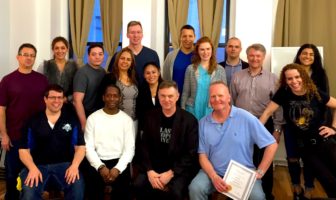Quotes
Ericksonian Hypnotic Language Patterns
Early in my NLP/Hypnosis training I was in Santa Cruz, California, attending a workshop. After class one day I walked along the beach with a more advanced student who knew a lot about language patterns. When I asked her how to begin gaining facility with them she turned to me and said, “you’ll find that the pattern called ‘Quotes’ is one of the easiest, yet most effective, patterns of all.”
She went on to explain, “When you quote somebody else, your listener doesn’t realize that you’re indirectly giving him or her a direct command. It goes right in!”
Now, I wasn’t sure if I believed her or not so I put it to the test. I’d be at a restaurant and say to the waiter, “my father always told me, ‘just make sure the food’s served hot and everyone will be happy.'” I’d ask a cop for directions and say, “My travel agent told me ‘Always ask a cop, because you’re really nice to tourists.'”
When you start to learn about “Quotes” you’ll notice them everywhere.
Storytellers will put them in the middle of a story or metaphor, where one character addresses another. “…and the cobbler said to the boy, ‘Remember, you’re only as happy as you make up your mind to be.‘”
They will have the quote appear as the thought or sudden realization of the main character. “…and Alice suddenly realized that it’s not how hard you work, it’s how you work hard.“
Quotes can be attributed to famous people. (It is likely even better when they actually said it.) “Benjamin Franklin always said, ‘The more you practice, the luckier you’ll be.’“
Referring to a previous client is useful in a variety of ways. Milton Erickson would often talk about an earlier patient and use the quotes pattern to give suggestions. “And as my client listened to me talk, she realized how true the old saying is that, ‘when you are in trance, you learn rapidly and effectively.‘”
Please note that in the above examples, the part of the quote that is the suggestion is put in the second person, present tense. In other words, because you want to tell your listener to do something, make sure the suggestion is in the form of “you do this,” or “you learn that.” NOT “she did this,” or “he learned that.”
So, now, I wonder what would happen if you were to write your own examples. Aristotle once said, “The best way to learn is by doing.”
So maybe you’ll want to write them out.
Maybe you’ll Say them aloud to a human being with the proper tonal shift. (See the earlier post about tonality if you need more clarity on that)
I’d write at least ten. You might want to write more. Or not.
Be careful when you use them with your spouse, but playfully use them with your pet (they’ll like it).
Most certainly use them with your clients.
Because as Milton Erickson once said that Mark Twain once wrote, “Don’t put off til tomorrow that you can just as easily do the day after that.”
😉





 Download Doug O’Brien’s paper,
“Be your Best with Self Hypnosis”
Download Doug O’Brien’s paper,
“Be your Best with Self Hypnosis”